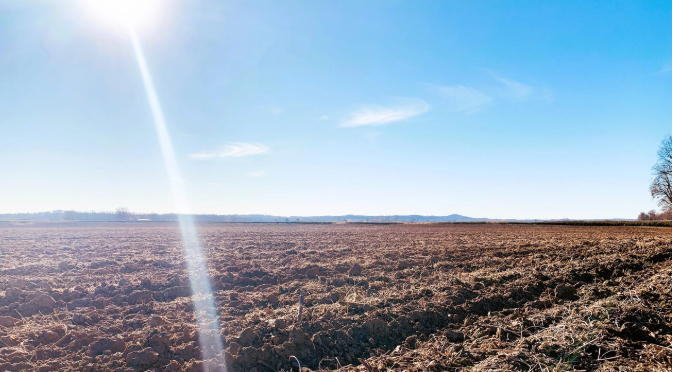December 31, 2025 | 15:10 GMT +7
December 31, 2025 | 15:10 GMT +7
Hotline: 0913.378.918
December 31, 2025 | 15:10 GMT +7
Hotline: 0913.378.918

There are surprising economics behind how you look at land in your business balance sheet. Land may technically be "free" due to appreciation outpacing interest rates, but farmers can't access that value until they sell. They must cover loan payments, limiting cash flow despite building wealth.
While speaking recently at a conference on the cost of making hay, I discussed some of the components such as fuel, fertilizer, machinery, land, interest and yield.
When I reached the slides on land expense, I told the audience to skip that section because land was actually free. Everyone looked at me like I was crazy, so, I had to explain.
Did you know that over the past 20 years, half the time, land was free?
Since 1950, USDA’s National Agricultural Statistics Service has been reporting the average value of farmland. Since that time, the value mostly continued to increase with only a handful of dips along the way.
Historically, long-term appreciation averaged 6%. However, over the past 20 years (80 quarters), the average interest rate farmers paid for land was 6.29%.
The Federal Reserve Bank of Kansas City uses its quarterly agricultural credit survey to report fixed interest rates paid by farmers for real estate loans within the 10th Federal Reserve District.
While some periods had unusually low interest rates, such as during the pandemic, over time, interest rates were below 6% for 39 of those quarters. Including the third quarter of 2018, when the rate was essentially 6% (6.01%), land was appreciating more than the cost (i.e. interest rates) farmers were paying for it 50% of the time. So, depending on when your loan began, essentially it may have been free.
If this is true, if land is free, why doesn’t everyone snatch it up?
Because, unfortunately, you can’t spend an asset’s appreciation until you cash it out or sell the asset. And in the meantime, you still have to make every payment, including the principal, to the bank to pay for it.
Yes, those payments do include principal payments for land over time, but yearly interest expense is the “cost” of making the purchase.
You may be building wealth (land appreciation is the backbone of a farmer’s retirement account), but you can’t spend land appreciation and continue to farm it.
When the government passed the Homestead Act of 1862 offering free farmland, people from all across the world rushed to claim 160 acres of free land and make their new home. To garner free land, all someone had to do was live on and make improvements to it. After five years, the person was entitled to the land free and clear.
It was a hard life carving a living out of the land, but American agriculture was considered the land of opportunity. And today, farmers still face many of the same struggles.
Commodity prices go up and down, input costs rise, and machinery gets more expensive. There are droughts, floods and diseases, but farming is still the American dream.
For those lucky enough to survive and make the payments for the next 20 years, you may find the land was going up in value more than you were paying each year in interest, and you ended up with some free land like the homesteaders did.
But I wouldn’t call it free. You’ll have earned it, just like they did.
Here are a few land value statistics from my home state of Missouri, but the pattern persists across the country.
In 1950, the average value was $64 per acre. By 2024, that figure rose to $4,800 per acre. For everyone screaming that’s too low or too high, remember it’s an average.
In some parts of the state, productive land is higher — much, much higher in fact. But there are also lower-value areas more suited for timber and hunting than homes or agriculture.
The yellow line in the table on this page shows the farmland values reported by NASS from 1950 to 2024. From 1950 to the early 1970s, price increases were modest. However, prices rose very quickly in the 1970s, and in the 1980s they fell just as fast.
A closer look reveals an interesting trend.
Beginning with the $64 per acre value in 1950, simply adding 6% appreciation each year creates the black line in the table. Under that premise, Missouri farmland stayed above the 6% trend line until 2017 when it finally crossed.
However, in 2023, it again climbed above trend. The 2024 farmland value of $4,800 is $27 above the trend line figure of $4,773.
(farmprogress)
/2025/12/29/0829-2-000508_274.jpg)
(VAN) Hai Phong is tightening management, with 100% of fishing vessels licensed and equipped with vessel monitoring systems, joining the national effort to lift the EC's 'yellow card.'
/2025/12/27/2744-1-121716_241.jpg)
(VAN) The Viet Nam Environment Protection Fund is the national environment protection fund and a state financial institution under the Ministry of Agriculture and Environment.
/2025/12/27/2015-2-111213_813.jpg)
(VAN) In efforts to realize the goal of Net Zero emissions, reducing urban emissions is regarded as a key solution.

(VAN) Deputy Prime Minister Tran Hong Ha requested to design the EPR mechanism toward a circular economy that is transparent, feasible, and non-administrative and aligned with actual recycling capacity.

(VAN) On December 24, Deputy Prime Minister Tran Hong Ha chaired a meeting about approving greenhouse gas emission quotas for 2025 - 2026 period.

(VAN) As Viet Nam enters a new era, the national agricultural sector must proactively adapt to global trends to transform current challenges into strategic development opportunities.
/2025/12/18/5046-3-154320_307.jpg)
(VAN) Granting planting area codes is a solution that helps Lao Cai manage forests effectively while also laying a data foundation to support the development of the carbon credit market in the future.